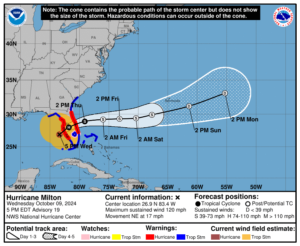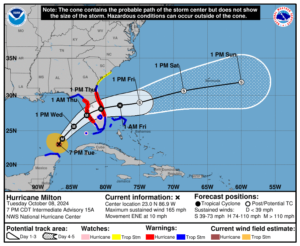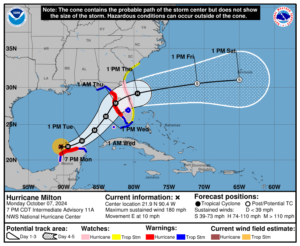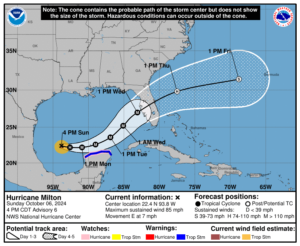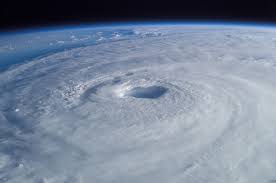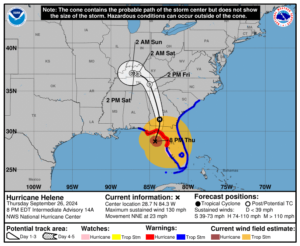WCF SECTION SPECIAL BULLETIN #24-14 – 1200 EDT – 10/10/24 – FINAL
HURRICANE MILTON – 1200 EDT – 10/10/24
Hurricane Milton made landfall at Siesta Key yesterday evening around 2030 EDT, moved through eastern Manatee, northwestern Hardee County, southern Polk County, northern Osceola and exited the east coast at Cape Canaveral in Brevard County around 0600 EDT this morning. Milton was beginning the process of transitioning into an extra-tropical area of low pressure as it was exiting the east coast of Florida. So we say to Milton, “bye bye and you are not welcome to come back ever again.”
COASTAL WATCHES/WARNINGS AND FORECAST CONE FOR STORM CENTER
SUMMARY OF 1700 EST…2100 UTC…INFORMATION
——————————————————————————-
LOCATION…29.1N 78.5W
ABOUT 135 MI…220 KM ENE OF CAPE CANAVERAL FLORIDA
ABOUT 205 MI…330 KM NNW OF GREAT ABACO ISLAND
MAXIMUM SUSTAINED WINDS…80 MPH…130 KM/H
PRESENT MOVEMENT…ENE OR 65 DEGREES AT 20 MPH…31 KM/H
MINIMUM CENTRAL PRESSURE…983 MB…29.03 INCHES
SUMMARY OF WATCHES AND WARNINGS IN EFFECT:
SUMMARY OF WATCHES AND WARNINGS IN EFFECT:
A Storm Surge Warning is in effect for…
* Sebastian Inlet Florida to Altamaha Sound Georgia, including the St. Johns River
A Tropical Storm Warning is in effect for…
* Sebastian Inlet Florida northward to Edisto Beach South Carolina
* Extreme northwestern Bahamas, including Grand Bahama Island and the Abacos
A Storm Surge Warning means there is a danger of life-threatening inundation, from rising water moving inland from the coastline in the indicated locations. For a depiction of areas at risk, please see the National Weather Service Storm Surge Watch/Warning Graphic,
available at hurricanes.gov.
A Tropical Storm Warning means that tropical storm conditions are expected somewhere within the warning area.
For storm information specific to your area in the United States, including possible inland watches and warnings, please monitor products issued by your local National Weather Service forecast office. For storm information specific to your area outside of the United States, please monitor products issued by your national meteorological service.
FORECAST DISCUSSION:
Milton is quickly taking on extratropical characteristics, with convection more closely aligned along a warm frontal boundary to the northeast than the center itself. Due to the structure evolution, it is likely that the strongest winds are located to the northwest of the center. The intensity is lowered to 70 kt, based on continuity from the previous forecast. Scatterometer passes are expected in a few hours and should allow us to get a better handle on Milton’s intensity and structure.
The hurricane has turned east-northeastward (065/17 kt). Milton is located within the base of a deep-layer trough located over the western Atlantic, and this feature should steer the storm eastward later today, with that motion continuing for the next 3 days. The NHC forecast is a little faster than the previous prediction to follow the recent trends in the model guidance.
Global model fields show low-level thickness contours packing closer together on the northwest side through the day, and it is therefore likely that Milton will complete extratropical transition by this afternoon or evening. Milton will still be a powerful
post-tropical cyclone, but its maximum winds are expected to gradually decrease during the next few days. The post-tropical low is expected to become diffuse and will likely dissipate in about 4 days.
SITUATION AND ACTIONS:
All Hurricane Warnings, Tropical Storm Warnings, and Storm Surge Warnings have been discontinued earlier today. The only warnings still in effect are localized Flood Warnings for various rivers in the ARRL West Central Florida Section.
As of 1200 EDT, there are slightly over 3.4 million customers in the State of Florida without electrical power at this time. Out of this number 1.9 million customers in the ARRL West Central Florida Section are without electrical power. That is 55 percent of the total customers without power in the State of Florida
The Section ARES Alert Level is currently still at a Level 1. All ARES Groups that are tasked with doing response are still deployed, but some will be expecting to demobilize soon. The latest status can be found on the main page of the Section website under the “ARRL West Central Florida Section ARES Alert Status.
All ARES, ACS, and CERT personnel are encouraged to continue to check the Tropical Weather Outlook issued four times daily by the National Hurricane Center. Currently there are two other tropical storms out in the Atlantic, which do not threaten the continental United States. However, this can change rapidly, so vigilance is the order of hurricane season.
LATEST NATIONAL HURRICANE CENTER INFORMATION:
Public Advisories: https://www.nhc.noaa.gov/text/refresh/MIATCPAT4+shtml/062052.shtml?
Forecast Advisory: https://www.nhc.noaa.gov/text/refresh/MIATCMAT4+shtml/062051.shtml?
Forecast Discussion: https://www.nhc.noaa.gov/text/refresh/MIATCDAT4+shtml/062053.shtml?
Latest GOES Satellite Floater Images and Loop: https://www.star.nesdis.noaa.gov/GOES/floater.php?stormid=AL142024#navLink
CONCLUSION
This will be the final bulletin for Hurricane Milton.

